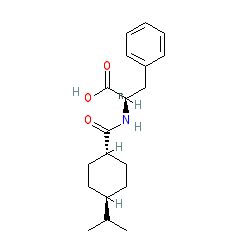GtoPdb is requesting financial support from commercial users. Please see our sustainability page for more information.
|
Synonyms: AY-4166 | SDZ-DJN-608 | Starlix®
nateglinide is an approved drug (FDA (2000), EMA (2001))
Compound class:
Synthetic organic
Comment: A sulfonylurea receptor 1, Kir6.2 blocker, but belonging to the metiglinides drug family. Note that the PubChem CID listed here is a slightly different isomer to the ChEMBL ligand and the INN structure.

View more information in the IUPHAR Pharmacology Education Project: nateglinide |
|
|||||||||||||||||||||||||||||||||||
| Bioactivity Comments |
| As we are unable to identify which subunit of the sulfonylurea receptor/potassium channel the drug binds, we have not tagged a primary drug target. |
| Targets where the ligand is described in the comment field | |
| Target | Comment |
| Peptide transporter 1 | Although most di/tripeptides can bind PEPT1, not all of them are substrates. The uptake depends on the structural features (charge, hydrophobicity, size, side chain flexibility, etc.) of the di/tripeptide. A variety of dipeptides and drugs interact with PEPT1, including D-Phe-Ala [9,22], D-Phe-Gln [1], cyclo(L-Hyp-L-Ser) (i.e. JBP485) [4,26], nateglinide [37], glibenclamide [31] and penicillin G (benzylpenicillin) [2]. Among many other molecules, PEPT1 has been shown to interact with L-Dopa-L-Phe [34,40], D-Phe-Gly-L-Dopa [43], JBP485 prodrugs (e.g. JBP485-3-CH2-O-valine, J3V) [20], 5-Aminosalicylic acid (5-ASA) derivatives (i.e. Gly-ASA, Glu-ASA, Val-ASA) [29,54], cinnabar (i.e. α-HgS >96%) [47], doxorubicin-tripeptide (i.e. doxorubicin-Gly-Gly-Gly) [12], scutellarin methyl ester-4'-dipeptide conjugates (e.g. scutellarin methyl ester-4'-Val-homo-Leu) [25], curcumin (CUR)-peptide derivatives (i.e. CUR-Phe-Val, CUR-Ile-Val) [55], gemcitabine amino acid ester prodrugs (i.e. 5'-L-valyl-gemcitabine, V-Gem) [32,39], decitabine amino acid ester prodrugs (e.g. 5'-O-L-valyl-decitabine, L-Val-DAC) [35-36], didanosine amino acid ester prodrugs (e.g. 5'-O-L-valyl-didanosine, L-Val-DDI) [53], floxuridine amino acid ester prodrugs (e.g. 5'-L-isoleucyl and 5'-L-valyl amino acid ester prodrugs of floxuridine) [23-24], floxuridine amino acid monoester prodrugs (e.g. 5'-O-D-valyl-floxuridine) [42], floxuridine dipeptide monoester prodrugs (e.g. 5'-L-phenylalanyl-L-tyrosyl-floxuridine, 5'-L-phenylalanyl-L-glycyl-floxuridine, and 5'-L-isoleucyl-L-glycyl-floxuridine) [41], amino acid acyloxy ester prodrugs of guanidine oseltamivir carboxylate (GOC) (e.g. GOC-L-Val, the L-valyl acyloxy ethyl prodrug of GOC) [16] and the valyl amino acid prodrug of GOC with the isopropyl-methylene-dioxy linker (i.e. GOC-ISP-Val) [19], amino acid acyloxy ester prodrugs of zanamivir (Zan, e.g. Zan-L-Val, the L-valyl acycloxy ethyl prodrug of Zan) [17], peramivir-(CH2)2-L-Val and peramivir-L-Ile [33], thiodipeptide prodrugs of for example, ibuprofen and propofol [10], alanylpyrraline (Ala-Pyrr) and pyrralylalanine (Pyrr-Ala) [11], dipeptide-bound derivatives of N6-(carboxymethyl)lysine (CML) and N6-(1-carboxyethyl)-lysine (CEL) (i.e. Ala-CML, CML-Ala, Ala-CEL, CEL-Ala) [18], Flammulina velutipes polysaccharide(FVP)-iron(III) complex [FVP-Fe(III) complex] [5], dipeptides of p-borono-L-phenylalanine (BPA) and tyrosine (i.e. L-Tyr-p-L-BPA (Tyr-BPA), p-L-BPA-L-tyrosine (BPA-Tyr)) [28] and AuIII‐peptidodithiocarbamato complexes of the type [AuIIIBr2(dtc‐AA1‐AA2‐OR], in which AA1 = N‐methylglycine (Sar), L/D-Pro; AA2 = L/D-Ala, α‐aminoisobutyric acid (Aib); R = OtBu, triethylene glycol methyl ether) (e.g. dtc‐Pro‐Aib‐OtBu) [3]. In recent years, PEPT1 has been shown to interact with a large variety of specifically targeted (i.e. peptide- or amino acid-functionalized) nanoparticles [6-8,13-14,48], (nano)micelles [21,44,46,52] and nanocomposites [15,45,50-51]. |
| Peptide transporter 2 | Although most di/tripeptides can bind PEPT2, not all of them are substrates. The uptake depends on the structural features (charge, hydrophobicity, size, side chain flexibility, etc.) of the di/tripeptide. Like PEPT1, PEPT2 interacts with dipeptides and drugs including D-Phe-Ala [9,38], nateglinide [37], glibenclamide [31], penicillin G (benzylpenicillin) [30], polymyxins (i.e. polymyxin B and colistin) [27] and entecavir [49]. PEPT2 has been shown to interact with dipeptides of p-borono-L-phenylalanine (BPA) and tyrosine (i.e. L-Tyr-p-L-BPA (Tyr-BPA), p-L-BPA-L-tyrosine (BPA-Tyr)) [28] and with AuIII‐peptidodithiocarbamato complexes of the type [AuIIIBr2(dtc‐AA1‐AA2‐OR), in which AA1 = N‐methylglycine (Sar), L/D‐Pro; AA2 = L/D‐Ala, α‐aminoisobutyric acid (Aib); R = OtBu, triethylene glycol methyl ether, e.g. dtc‐Pro‐Aib‐OtBu) [3]. |







